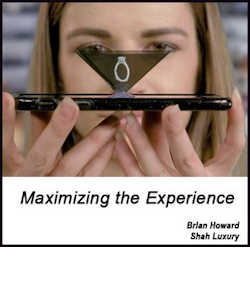Virtual Experiences Keep Customers Engaged
Excellent customer service results in brand loyalty.
Customer service is at the core of a jeweler’s brand integrity, particularly for independent jewelers, from hosting exclusive events to engaging with customers on a deeply personal level.
While the pandemic made it challenging to have face-to-face personal relationships with customers, it did accelerate the jewelry industry’s embrace of technology to simulate the in-store experience.
 “Over the years, online retailers have sought to close that gap between online and offline through various digital customer experiences. These solutions seek to simulate the personal customer service experience offered at a traditional brick and mortar level,” shares Derek Kristopher, the associate director of marketing for the New York City-based manufacturer S.D.C Designs, in a Plumb Club podcast, The Digital Transformation.
“Over the years, online retailers have sought to close that gap between online and offline through various digital customer experiences. These solutions seek to simulate the personal customer service experience offered at a traditional brick and mortar level,” shares Derek Kristopher, the associate director of marketing for the New York City-based manufacturer S.D.C Designs, in a Plumb Club podcast, The Digital Transformation.
But brick-and-mortar jewelers are leaders when it comes to customer service, and in the virtual realm, they can continue to provide the superior kind of concierge services for which they are best known.
“Where jewelers, especially independents, can win is in the omni channel experience, providing the real boutique services for which they’re known, wherever shoppers find them,” describes Neil Shah, Shah Luxury, jewelry manufacturer and IT developer in New York City.
There are so many ways to provide concierge services virtually, Shah cites, including video conferencing, social media platforms like Facebook and Instagram, email, and applications that enable experiences like virtual try-ons and 3D holograms that elevate consumer engagement and purchase confidence.
Virtual Meetings:
Today, it’s easier than ever to replicate the in-store buying experience, says Ryan Hakimi, vice president of the New York diamantaire, C.H. Hakimi, in a Plumb Club podcast, Automating Jewelry. “The technology is out there. Visitors can visit a retailer’s gallery and see a 360-degree view, or visit a virtual showroom and have a one-on-one appointment in a live setting.”
A big success for jewelers, from independents to large retailers like Signet, has been virtual appointments, one-to-one video calls with customers to showcase products of personal interest, cites Kristopher, who suggests jewelers include a “request a virtual appointment” on their website to reinforce that personal touch.
 Its value and benefits are rooted in two things — virtual sales and Client Relationship Management (CRM). It’s happening B2C and B2B, with The Plumb Club’s TPC-365 sales meeting platform a compelling example. In development for almost two years and launched last September, the platform debuted its second phase this April, immersive 3D showrooms. The interactive experience allows visitors to explore Plumb Club companies (imagery, history, products) and request-click a virtual meeting.
Its value and benefits are rooted in two things — virtual sales and Client Relationship Management (CRM). It’s happening B2C and B2B, with The Plumb Club’s TPC-365 sales meeting platform a compelling example. In development for almost two years and launched last September, the platform debuted its second phase this April, immersive 3D showrooms. The interactive experience allows visitors to explore Plumb Club companies (imagery, history, products) and request-click a virtual meeting.
“We use TPC365 often,” says Steven Lerche, vice president of sales and operations for the New York City-based manufacturer Goldstar Jewellery, who is part of a Plumb Club compliance committee helping to perfect the platform. “It provides a great way for us to show new products to our customers virtually while allowing an interactive experience for them to feel more involved in the selection of products. TPC-365 helps us to cater proposals to our customer’s needs, track their selections, and export to work in any arena we need, whether it be virtual, in person, or through email. The system also saves that information for future access.”
“We incorporate a suite of light boxes, high definition cameras, and 360 live videos to facilitate our B2B,” Lerche explains. “Many of those videos and high-def imaging services directly help our retailers market their online items and .com business to the consumer.” He notes that customers like Helzberg and Signet have been great partners in working remotely to manage the business through digital platforms, as well as with their customers on a B2C level.
Virtual Pop-Ups & Live Events:
Next to virtual appointments, virtual pop-ups and live events are popular ways of offering something exclusive and unique for your brand community, Kristopher shares. It could be an interview with a special guest, like a brand designer, a behind-the-scenes look at how something is made, or the launch of a collection. There are many live-stream platforms available and social media options for live events, with FaceBook and Instagram popular.
 Sharing his tip for success, John Carter, owner of Jack Lewis Jewelers in Bloomington, Illinois, says the approach to social media that works for his business has been to treat it like a TV station. “We empower our associates to shine, using their passions and talents, like photography and making videos, inviting clients to get to know them as people.” Team members star in features posted weekly, often about town, showcasing the local community.
Sharing his tip for success, John Carter, owner of Jack Lewis Jewelers in Bloomington, Illinois, says the approach to social media that works for his business has been to treat it like a TV station. “We empower our associates to shine, using their passions and talents, like photography and making videos, inviting clients to get to know them as people.” Team members star in features posted weekly, often about town, showcasing the local community.
Social Media is a must because it’s the online space that allows businesses to reach their audience and generate brand awareness, engagement, sales, and revenue, underscores Ji Ji Lee, Marketing Director for the New York City-based manufacturer Jewelmark, in a Plumb Club podcast, 5 Modern Marketing Tips.
Lee shares that video formats, such as Instagram and Facebook Stories, video ads (incredibly interactive and shoppable), and augmented reality, have proven to garner greater reach and engagement than static images. However, they have their place in the mix. Brands can gauge this information in real-time with customers and use those findings to create and modify their digital content.
Virtual Try On & 3D Hologram Technology:
Technology can help consumer concerns and ease purchase decisions by building confidence and demonstrating what pieces look like from various perspectives and how they will look when worn. It shares Brian Howard, vice president of sales and marketing for Shah Luxury, in a Plumb Club podcast, Maximizing the Experience. The company not only manufactures jewelry, but it also has become an IT developer to bring technology to its customers that makes business more effective, efficient, and engaging.
The company’s virtual try-on application allows customers to visualize a piece of jewelry using an existing product image or rendering of a design before a piece is built, Howard describes. “You can scale it up or down, rotate it; it’s like new age technology of photoshopping the jewelry. It takes about 45 seconds to pull up and share with customers, who can save images to share with others for feedback or to drop a gift hint.

Regarding hologram technoolgy, Howard mentions that it came into play in the jewelry industry a few years back but was limited in capability. Today, the technology offers 3D, Ultra HD, and Virtual Reality that brings jewelry to life.
Using a hologram machine or box, even a smartphone or tablet, customers can view, in mid-air, a piece from every angle, 360 degrees, and in full color. Moreover, you can change metal color or gemstone in the design as it floats before you. The brand, for which half its business is custom work for jewelers, cites sales conversion rates for jewelers using the technology as 30% to 40%.











